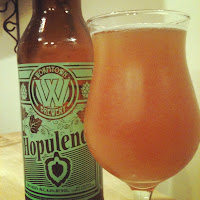Heady Topper - The Alchemist
John Kimmich, The Alchemist, has a created a truly spectacular Imperial IPA. Heady Topper provides blast of bright tropical fruits: pineapples, mangos and oranges that provide a taste unlike any other bitter beer that I have tried. With just enough malt to maintain some ideals of balance, Heady Topper drinks almost like fruit juice, which could be quite devilish at its 8%ABV. For all the hopheads out there, this beer rivals Pliny the Elder, Hopslam and many of the unbelievably hoppy beers brewed by the Alpine Beer Company.
Mycernary - Odell's Brewing Company
The aroma of the Myrcenary is amazing. It is bright, rich, citrusy, and mildly dank. The clarity of this Imperial IPA is reminiscent of pilsner or kolsch, which to me, shows the brewer's craftsmanship. The taste is everything you want in a Double IPA: massive hop character with just enough malt backbone to keep it from becoming a hop bomb. Tropical fruits are abundant from beginning to end with pineapples and mangos dominating much of the flavor. The ability to have this beer super fresh, at the taproom in Fort Collins, COL., undoubtedly enhanced the beer's character leaving a truly long lasting impact on my taste buds to this day.
On the Wings of Armageddon - DC Brau
My brother-in-law, Baumbusch, recently graduated from The George Washington University in Washington, DC. On our last trip to the nation's capital (graduation in May), he introduced me to a new (at the time) brewery that he loves, DC Brau. At the ChurchKey, I tried On the Wings of Armageddon and was absolutely blown away. This 100% Falconer's Flight hopped beer wafts an intense-aromatic nose that is slightly bready. The head retention is one of this beer's best characteristics, refusing to break, but when it does, intricate lacing covers the glassware. When in the nation's capital, be sure to check out the brewery, I don't think you'll be disappointed.
Edward - Hill Farmstead Brewery
During Extreme Beer Weekend in Boston, I was fortunate enough to attend a Hill Farmstead tap takeover at Lord Hobo in Cambridge, MA. Edward, Shaun Hill's liquid homage to his grandfather, is the best pale ale that I have ever tried. At 5.2% and 85IBUs, Shaun Hill has created an unbelievably drinkable, yet aggressively hop forward pale ale that delivers on all levels: sessionability, flavor and enjoyment. Its tropical fruit characteristics and piney-spicy finish make it truly unforgettable and a must try for all craft beer enthusiasts.
Kipling - Thornbridge Brewery
On BeerAdvocate, Kipling, is classified as an English Pale Ale. I disagree with this classification because of the hop varietal, Nelson Sauvin that is used exclusively in this beer. This New Zealand hop varietal imparts pineapple and tangerine qualities to the beer that balance very well with the Maris Otter Malt creating a truly distinctive pale ale, neither English or American; Its Thornbridge. At 5.2%ABV, this beer has become my favorite, "somewhat" readily available session beer. I hope to have this beer on cask some day soon, so I can further gain an appreciation for well-designed and tasty real ale.
Indra Kunindra - Ballast Point Brewing Company
Have you ever had a moment where you had to convince yourself about something continuously to make sure that it's true? Well, the first time I sampled Indra Kunindra, I had such a moment. I had to keep telling my brain that yes, I am drinking beer. This Foreign Export stout is brewed with a plethora of exotic ingredients that created a tasting that flowed from coconut to lime ending with chile spiciness. Holy crap! This is a very unique beer and I hope Ballast Point continues to experiment with very exotic ingredients to the success of this product.
Grande Cuvee Baltic Porter - Les Trois Mousquetaires
Winner of the 2010 World Beer Cup in the style of Baltic Porter, The Three Musketeers have a created what many believe is the prefect porter. Almost fully opaque, this robust full-bodied ale abounds with flavor. Bitter chocolate, hints of smoke and subtle cherry blend for an amazing tasting experience with flavor-upon-flavor. If you love porters and/or stouts this beer delivers on all levels and deserves to be sought out. When you find it, buy it!

Petite Sour - Crooked Stave Artisan Beer Project
Chad Yakobson and his wild yeast strains have developed an almost cult following among beer geeks. This beer poured very cloudy, reminding me of a classic witbier. There is a wonderful, puckering sour that almost overwhelms the back portion of the palate. Lemon is the dominate flavor, but other fruits, grannie smith apples and lime, compliment the lemon very well. The "Brett" control in this beer was very well done because it didn't overpower any of the other flavors. A fantastic sour ale from an ingenious beer blender and cellarer.
Westvleteren 12 - Abbey of Saint Sixtus
The highlight of my beer consumption this year, Westy 12 may be the most complex ale I have ever tasted in my life. Instantly, dark, rich fruits: prunes, dates and figs coat the palate. In balance with these dark fruits were the grains creating hints of toffee and caramel. The mouthfeel was very creamy and contained an appropriate level of carbonation. At 10.2% ABV, this beer is unbelievably smooth. The alcohol content is so well hidden, you feel as though this dark ale is sessionable. As crazy as that sounds, its true. If you ever have the opportunity to share this truly great beer, please respect and cherish it!
I had a great year of beer consumption with friends and family. I hope you had an amazing year as well.
I cant wait to see what 2013 holds for innovation, collaboration and acculturation for the craft beer community.
Cheers,
PandaMack












































